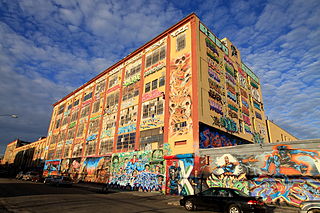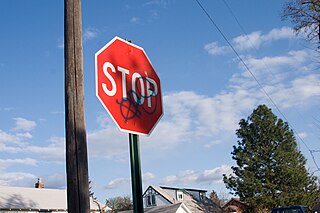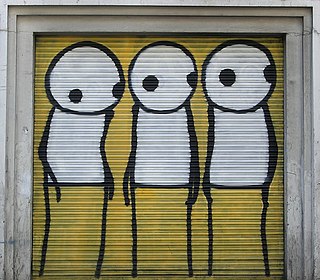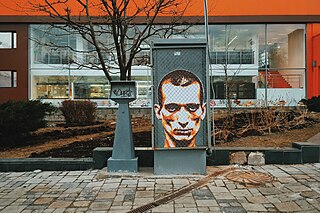Related Research Articles

Graffiti is art that is written, painted or drawn on a wall or other surface, usually without permission and within public view. Graffiti ranges from simple written words to elaborate wall paintings, and has existed since ancient times, with examples dating back to ancient Egypt, ancient Greece, and the Roman Empire.

Sticker art is a form of street art in which an image or message is publicly displayed using stickers. These stickers may promote a political agenda, comment on a policy or issue, or comprise a subcategory of graffiti.

Banksy is a pseudonymous England-based street artist, political activist, and film director whose real name and identity remain unconfirmed and the subject of speculation. Active since the 1990s, his satirical street art and subversive epigrams combine dark humour with graffiti executed in a distinctive stenciling technique. His works of political and social commentary have appeared on streets, walls, and bridges throughout the world. His work grew out of the Bristol underground scene, which involved collaborations between artists and musicians. Banksy says that he was inspired by 3D, a graffiti artist and founding member of the musical group Massive Attack.

Street art is visual art created in public locations for public visibility. It has been associated with the terms "independent art", "post-graffiti", "neo-graffiti" and guerrilla art.

OSGEMEOS are identical twin street artists Otavio Pandolfo and Gustavo Pandolfo. They started painting graffiti in 1987 and their work appears on streets and in galleries across the world.
Mural Arts Philadelphia is a non-profit organization that supports the creation of public murals in Philadelphia, Pennsylvania. Founded in 1986 as Mural Arts Program, the organization was renamed in 2016. Having ushered more than 3,000 murals into being, it calls itself "the nation’s largest public art program". As of 2022, the organization says it runs 50 to 100 public art projects each year; it also works to maintain existing murals.
Eyebeam is a not-for-profit art and technology center in New York City, founded by John Seward Johnson III with co-founders David S. Johnson and Roderic R. Richardson.
Melbourne, the capital of Victoria and the largest city in Australia, has gained international acclaim for its diverse range of street art and associated subcultures. Throughout the 1970s and 1980s, much of the city's disaffected youth were influenced by the graffiti of New York City, which subsequently became popular in Melbourne's inner suburbs, and along suburban railway and tram lines.

5 Pointz: The Institute of Higher Burnin' or 5Pointz Aerosol Art Center, Inc., mainly referred to as simply 5 Pointz or 5Pointz, was an American mural space at 45-46 Davis Street in Long Island City, Queens, New York City. When the building opened in 1892, it housed the Neptune Meter factory, which built water meters.

The Bristol underground scene is a cultural movement in Bristol beginning in the early 1980s. The scene was born out of a lack of mainstream clubs catering for the emergence of hip hop music, with street and underground parties a mainstay. Crews formed playing hip hop in disused venues with sound systems borrowed from the reggae scene: City Rockers, 2 Bad, 2 Tuff, KC Rock, UD4, FBI, Dirty Den, Juice Crew, Rene & Bacus, Soul Twins, KC Rock, Fresh 4, and the Wild Bunch were among them. These names were the precursors to the more well known names that came from this scene. It is characterized by musicians and graffiti artists. The scene was influenced by the city's multiculturalism, political activism, and the arts movements of punk, reggae, hip hop, hippies and new age.
SAMO is a graffiti tag originally used on the streets of New York City from 1978 to 1980. The tag, written with a copyright symbol as "SAMO©", and pronounced Same-Oh, is primarily associated with the artist Jean-Michel Basquiat, but was originally developed as a collaboration between Basquiat and Al Diaz.

Yarn bombing is a type of graffiti or street art that employs colourful displays of knitted or crocheted yarn or fibre rather than paint or chalk. It is also called wool bombing, yarn storming, guerrilla knitting, kniffiti, urban knitting, or graffiti knitting.

Graffiti are writing or drawings scribbled, scratched, or sprayed illicitly on a wall or other surface in a public place. Graffiti ranges from simple written words to elaborate wall paintings. Graffiti, consisting of the defacement of public spaces and buildings, remains a nuisance issue for cities.

Graffiti in New York City has had a substantial local, national, and international influence.

Graffiti in Toronto, Ontario, Canada, is a cause of much disagreement among its residents. Graffiti is seen by some as an art form adding to the Toronto culture; however, others see graffiti as form of vandalism, viewing it as ugly, or as a form of property damage.
Islamic graffiti is a genre of graffiti created by people who usually relate to the Middle East or North Africa, using Arabic or other languages for social or political messages. It is a popular art genre created by "artists, graffiti writers, designers and typographers from the Middle East and around the world who merge Arabic calligraphy with the art of graffiti writing, street art and urban culture."
In recent years, Atlanta has become one of the USA's best cities for street art. Street artists have prominently created murals in Krog Street Tunnel, along the BeltLine, and in neighborhoods across the city. The street art conference, Living Walls, the City Speaks, originated in Atlanta in 2009.

Stik, stylised as STIK, is a British graffiti artist based in London. Born in 1979, with no formal art school training, Stik to known for painting large stick figures that are six-lines, and two-dot figures.

In Russia, graffiti is an ambiguous phenomenon, i.e. considered to be desecration by some, and art by others. It is done for a variety of reasons, including expressing oneself through an art form, or protesting against a corporation or ideology.

In Hong Kong there are a few types of graffiti that are utilized for different reasons. The face of artist Ai Weiwei is one of the more well-known caricatures in the region. Journalist and commentators have considered the graffiti as "street-art", "creative" and the "voice of the young".
References
- ↑ "Dotmasters". Widewalls.ch. Retrieved 4 November 2018.
- ↑ "Anatomy of a backlash 2". News.bbc.co.uk. 17 July 2001. Retrieved 4 November 2018.
- ↑ "Artists in Non-Residence - Mute". Metamute.org. Retrieved 4 November 2018.
- ↑ "Street Art Dealer: Spray it, sell it". Wired.com. Retrieved 4 November 2018.